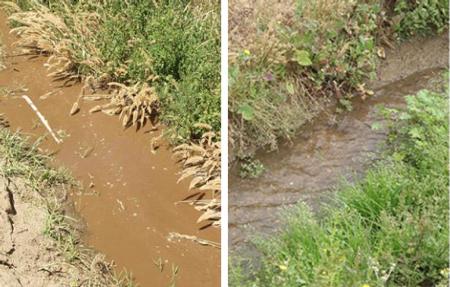Summer 2013: Improving water quality with polyacrylamide (PAM) polymers
Regional Report for Santa Cruz and Monterey Counties by Steve Tjosvold
Federal and state water quality regulations require that growers implement management practices to minimize impairments to surface and ground water quality. Many nursery operators have made significant progress in mitigating this problem. They use retention ponds and water recycling that can significantly control and reuse excess runoff from irrigations (tailwater), but these practices can be expensive and may not be suited for all production facilities.
Nursery operators use drip irrigation to increase irrigation efficiency for larger nursery stock and slow release fertilizers to maximize nutrient uptake by the crop. Integrated pest management is practiced to reduce pesticide use. But additional management tools are still needed to help minimize impairments to water quality.
Many research studies in field crops have repeatedly demonstrated that linear anionic polyacrylamide (PAM), a chemical polymer, can significantly reduce sediment and nutrient concentrations in tailwater. PAM has been used successfully in furrow and sprinkler irrigation to improve soil infiltration, reduce soil erosion and improve water quality by causing sediment — which contains nitrogen, phosphorus and adsorbed pesticides — to form clumps and settle out before moving off site in tailwater.
PAM has been proven to be nontoxic to humans and safe to use in field crops. It is inexpensive and a readily available product too. It is approved for water quality mitigation by the USDA Natural Resources Conservation Service (NRCS) and the California’s Regional Water Quality Control Boards (RWQCBs). PAM has been successfully used in furrow and sprinkler irrigation to improve infiltration, reduce erosion and improve water quality. These techniques can be adapted for use in field or greenhouse ornamental production.
Water Quality Efficacy of PAM in Furrow Systems
Most applications of PAM in furrows are done by adding dry or liquid product to water flowing in the head ditch or the main line (if gated pipe is used) at a rate to achieve a 2.5 to 10 ppm concentration. The application is made continuously during the irrigation or until the water advances almost to the end of the furrows.
An alternate application method (“patch method”) involves applying granular PAM to the first 3 to 5 feet of the head of each furrow. Granular PAM slowly dissolves during the irrigation, releasing product into the water.
Tablet forms of PAM can also be applied to the beginning of each furrow. Since the PAM tablet dissolves slowly, this application method releases less product into the irrigation water than the other methods described, and can be less effective in controlling sediment and associated nutrients and pesticides. However, because the tablet formulation of PAM dissolves slowly, it may last for several irrigations, thereby saving labor.
Water Quality Efficacy of PAM with Overhead Sprinklers
Applications made before sprinkler irrigating, such as by spraying PAM solution or broadcasting dry product on the surface of the soil, are less effective than continuously injecting a low rate of PAM into the irrigation water. Injecting PAM at a high rate for a short period at the beginning of irrigation is less effective in controlling sediment and nutrients in runoff than a continuous application at a low concentration during the entire irrigation.

For more information, see “A Guide to Using Polyacrylamide (PAM) Polymers for Control of Irrigation Runoff on the Central Coast” by Michael Cahn, UC Cooperative Extension Irrigation and Water Resources Advisor, Monterey County. This publication is available online at http://cesantabarbara.ucanr.edu/files/75493.pdf.
Steven A. Tjosvold
Farm Advisor, Environmental Horticulture
UC Cooperative Extension Santa Cruz County
1432 Freedom Boulevard
Watsonville, CA 95076-2796
(831)763-8013 phone, (831) 763-8006 fax
satjosvold@ucanr.edu
http://cesantacruz.ucdavis.edu












